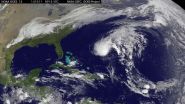US college students eat their vegetables. Really?!
2014-10-14
(Press-News.org) U.S. college students do better than their counterparts in the United Kingdom when it comes to physical activity, a healthy diet and less smoking, according to new research published in the latest issue of the journal Education and Health.
"Among U.S. students, we see greater consumption of fruits and vegetables, more participation in organized sports, and less smoking," said American University Prof. Stacey Snelling, a lead study author. "Participation in organized sports and exercise could reflect the more formal focus on physical activity at the college level that we have in the U.S. The study shows that certain policies and laws in the U.S. are making an impact, particularly with regard to smoke-free campuses."
More than twice as many college students in the U.K. identified as smokers -- 39 percent compared with 16 percent in the U.S. Tobacco- and smoke-free campuses are a growing trend in the U.S. There are 1,478 smoke-free campuses, according to the group American Nonsmokers' Rights Foundation. Of these, 976 are 100 percent tobacco-free, and 292 prohibit the use of e-cigarettes anywhere on campus.
Snelling and her colleagues examined data from a sample of self-reported health behaviors of university students in the U.S. and U.K. Data came from the American College Health Association, which collects survey information on student health behaviors, such as tobacco use, weight, nutrition and exercise, campus safety, and mental and physical health. Data was gathered in the U.K., using a survey with slight word changes in British English. Survey respondents were 23 or younger and mostly women. Snelling's colleagues included health economics Prof. Heather Gage and Peter Williams, a statistics consultant, of the University of Surrey, England.
Health education on campus
The health of college students is a growing concern in both countries. Increasing numbers of American students are reporting psychological problems to student counseling services. In the U.K., 29 percent of students have psychological distress that meets standards for clinical diagnosis.
An important takeaway from the study for both countries, Snelling said, is how to improve health education and wellness on college campuses.
"Health education programs on college campuses need to catch the attention of young folks. In the U.S. we have creative ways of reaching students through social marketing and peer-to-peer education, among other methods," Snelling said. "But the study results raise the question of where we can improve, also in the U.S., on how colleges and universities can have more coordinated programming to address the whole student."
Regarding fruit and vegetable consumption, college dorm policies in the U.S. are having an impact, the study found. Residence hall policies encourage nutritionally balanced meals, healthy eating and meal plans, for example. In contrast, students in England are more likely to prepare their own food, making eating healthy less convenient or more costly. U.K. students ate 1.5 fruits or vegetables per day compared with U.S. students who ate 3.5, the study found.
Both groups of students reported undertaking a breast self-exam at the same rate, but preventive care appointments, such as gynecological and dental, were greater for U.S. students.
Alcohol consumption and weight concerns
The sampling revealed similar findings for the numbers of students who consume alcohol and those with concerns about weight. More than half of students in both countries said they had exercised to lose weight in the last 30 days.
"Alcohol consumption remains a challenge for colleges and universities in both countries and continues to need addressing," Snelling said. "The focus on weight is a reminder of the challenge in educating students that health is about fitness and nutrition and less about a number on a scale."
In both countries, more students are entering higher education, with participation rates approaching 50 percent. Many students face financial pressures and concerns about succeeding in a competitive global job market. Struggle to follow health-enhancing behaviors affect the risk of chronic conditions in adulthood, as college is often the time in life where habits form that will continue through a lifespan.
"U.S. students in general reported better health, healthier lifestyles and more access to preventive services. This could reflect a difference in how the two countries approach health care," Snelling said. "Regardless, academic achievement and health are highly related and healthier individuals are better learners. Universities need to work to create a culture that supports intellectual growth and promotes health."
INFORMATION:
[Attachments] See images for this press release:

ELSE PRESS RELEASES FROM THIS DATE:
2014-10-14
First-hand experience of extreme weather often makes people change their minds about the realities of climate change. That's because people are simply more aware of an extreme weather event the closer they are to its core, and the more intense the incidence is. So says Peter Howe of Utah State University in the US, who led a study in Springer's journal Climatic Change Letters about people's ability to accurately recall living through extreme weather events. It also focused on how people's proximity to such events – the so-called "shadow of experience" – aids ...
2014-10-14
Ithaca, N.Y.—They are some of the brightest, loudest, oddest-looking, least-understood birds on the planet. Some have bulbous crests, long fleshy wattles, or Elvis-worthy pompadours in addition to electric blue, deep purple, or screaming orange feathers. But thanks to a comprehensive new evolutionary "tree of life" generated for the tropical cotinga family of South America, the door is now open to new discoveries about the more than 60 species in this amazingly diverse group of birds.
"Our study provides comprehensive insight into how nearly all the cotinga species ...
2014-10-14
New Rochelle, NY, October 14, 2014—For the 5-15% of patients with mild traumatic brain injury (mTBI) who will have lingering physical, behavioral, or cognitive problems 3 to 6 months after their injury, identification of this at-risk population is essential for early intervention. Existing models used to predict poor outcomes after mTBI are unsatisfactory, according to a new study, and new, more relevant predictive factors are different than those used in cases of moderate or severe TBI, as described in the study published in Journal of Neurotrauma, a peer-reviewed ...
2014-10-14
VIDEO:
Some children with advanced retinoblastoma are not good candidates for conventional intraocular ophthalmic infusion therapy -- too often making removal of the eye the only viable treatment for saving their...
Click here for more information.
CINCINNATI – Doctors at Cincinnati Children's Hospital Medical Center have developed a new technique for treating the eye cancer retinoblastoma to improve the odds for preventing eye loss, blindness or death in children with ...
2014-10-14
Tropical Storm Gonzalo intensified into a hurricane late on Monday, Oct. 14 and is expected to become a major hurricane as it moves toward Bermuda. NASA's Aqua satellite saw powerful thunderstorms within the center of the storm that were dropping heavy rainfall.
At 5 pm EDT, on Oct. 13 Gonzalo had become a hurricane. At that time, the center of the storm was just 20 miles southeast of St. Martin. The National Hurricane Center (NHC) noted that maximum sustained winds had increased to near 75 mph (120 kph) and additional strengthening was forecast. Gonzalo continued moving ...
2014-10-14
Astronomy & Astrophysics is publishing the spectacular discovery of meteorite fragments 20 years after the corresponding bolide was seen in the skies of the Czech Republic. This discovery was made possible by reanalyzing the trajectory, which moved the impact line by 330 meters. Interestingly, the meteorites found on the ground are of different types, pointing to a parent asteroid of heterogeneous composition.
Collisions of meter-sized meteoroids with the Earth's atmosphere are relatively rare, occurring about 40 times a year. They cause very spectacular events, known ...
2014-10-14
Swedish and Chinese researchers show how a unique nano-alloy composed of palladium nano-islands embedded in tungsten nanoparticles creates a new type of catalysts for highly efficient oxygen reduction, the most important reaction in hydrogen fuel cells. Their results are published in the scientific journal Nature Communications.
The world's rapidly growing demand for energy and the requirement of sustainable energy production calls for an urgent change in today's fossil fuel based energy system. Research groups worldwide work intensively to develop novel advanced energy ...
2014-10-14
Numerous fires (marked with red dots) are burning in the Ukraine, likely as a result of regional agricultural practices. The body of water at the lower left of this true-color Moderate Resolution Imaging Spectroradiometer (MODIS) image is the Sea of Azov. The Sea is bordered by Ukraine to the northwest, west and southwest and by Russia to the northeast, east, and southeast. To its left is the Black Sea.
The location, widespread nature, and number of fires suggest that these fires were deliberately set to manage land. Farmers often use fire to return nutrients to the soil ...
2014-10-14
The Moderate Resolution Imaging Spectroradiometer (MODIS) on NASA's Aqua satellite detected fires burning in Western Australia on October 14, 2014. Matching these hot spots up to the the prescribed fire burns on Western Australia's parks and wildlife site: http://www.dpaw.wa.gov.au/management/fire/prescribed-burning/burns these fires are most likely prescribed burns used to limit bushfire outbreaks. According to the Government of Australia's Department of Parks and Wildlife, "Prescribed burning is the process of planning and applying fire to a predetermined area, under ...
2014-10-14
Pancreatic cancer likely takes between 10 and 20 years to develop, providing the potential for a very "broad window" of intervention if detected early, which may be possible for people who inherit a predisposition, say Australian clinical researchers.
Dr Jeremy Humphris and Professor Andrew Biankin1, from Sydney's Garvan Institute of Medical Research, analysed medical histories and tumour samples taken from a cohort of 766 pancreatic cancer patients, operated on between 1994 and 20122. Roughly 9% of these patients had a first-degree relative (parent or sibling) with ...
LAST 30 PRESS RELEASES:
[Press-News.org] US college students eat their vegetables. Really?!






